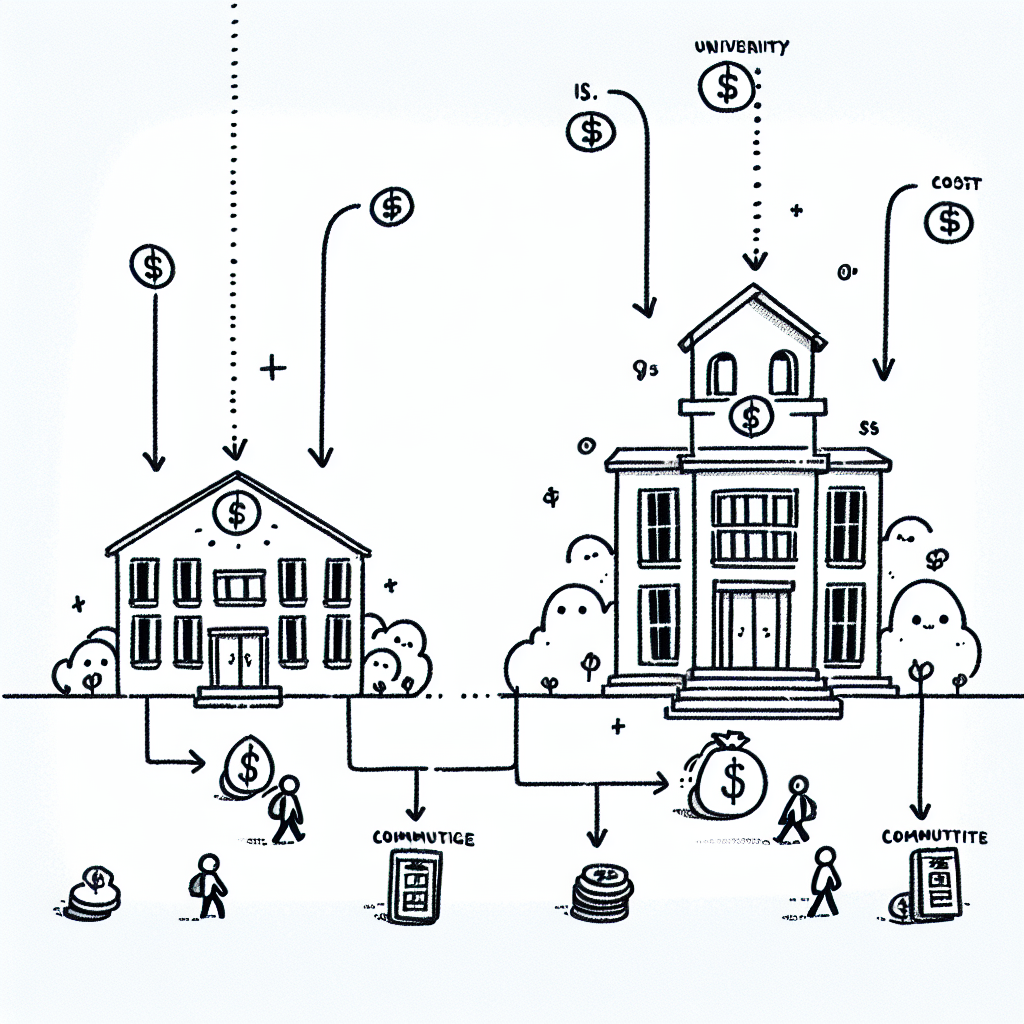Introduction
Cost plays a critical role in higher education decisions. For many students and families, affordability can determine where—and whether—someone attends college. In the debate of community college vs university cost comparison, understanding the full financial picture is essential.
Community colleges and universities often have distinctly different cost structures. Tuition, fees, housing, and other expenses can vary significantly between the two. Knowing these differences helps students make informed and realistic financial plans.
Transparent cost comparison provides clarity. By using tools and reviewing up-to-date statistics, students can better understand what they are paying for and why. This kind of clarity is crucial when comparing the cost of attending a community college versus a university.

Types of Costs in Higher Education
When conducting a community college vs university cost comparison, it's important to distinguish between direct and indirect costs associated with attending each type of institution.
Direct Costs
Tuition and Fees Community colleges generally have significantly lower per-credit-hour tuition rates compared to universities. This is especially advantageous for students taking general education courses early in their academic careers. Universities, on the other hand, tend to have higher base tuition, particularly for out-of-state students, which can substantially increase the overall cost of attendance.
Books and Supplies The cost of books and supplies tends to be comparable across community colleges and universities. However, some community colleges have made strides in reducing these expenses by offering more open educational resources (OER), which are freely accessible and openly licensed learning materials.
Indirect Costs
Room and Board Community colleges are often commuter-based, meaning students typically live at home and travel to campus. This setup can eliminate or significantly reduce housing and meal plan expenses. In contrast, many universities require first-year students to live on campus, which adds to the total cost of attendance through mandatory room and board charges.
Transportation and Personal Expenses Due to their local nature, community colleges may result in lower transportation costs for students who live nearby. Personal expenses can vary, but students at community colleges may face fewer added costs related to campus living and associated activities.
Understanding these direct and indirect cost differences is essential in a community college vs university cost comparison.

Statistical Comparison of Costs
National Data Overview
When considering a community college vs university cost comparison, national data highlights stark differences in tuition expenses. According to recent figures:
- Community Colleges: The average annual tuition is approximately $3,800.
- Public Universities (In-state): Students pay around $10,900 annually.
- Private Universities: Tuition averages a significantly higher $39,400 per year.
These numbers illustrate the financial advantage of starting at a community college. For students pursuing a bachelor’s degree, beginning at a community college for the first two years and then transferring to a four-year institution can substantially lower the total cost of education. This two-year vs four-year cost trajectory is a key factor in the community college vs university cost comparison.
Key Resources for Research
For those looking to conduct their own community college vs university cost comparison, several reliable tools from the National Center for Education Statistics (NCES) are available:
- NCES College Navigator: Helps users compare tuition, fees, student aid, and net price data across institutions nationwide.
- NCES Data Feedback Reports: Offers customized reports showing tuition and fee comparisons between selected schools.
- NCES College Navigator - Institution Search: Provides detailed financial information for specific colleges, including graduation rates and student debt levels.
- NCES College Navigator - Advanced Search: Allows users to filter schools by location, program, degree type, and tuition brackets to identify affordable options.
- NCES Institution-Specific Data Feedback Reports: Offers in-depth analysis of institutional cost structures and available financial aid.
These tools are essential for anyone conducting a detailed community college vs university cost comparison and seeking to make informed financial decisions about higher education.

Financial Aid and Net Price
Understanding the difference between sticker price and net price is essential when evaluating community college vs university cost comparison. The sticker price is the published cost of tuition and fees, but the net price reflects what students actually pay after financial aid is applied. Financial aid—including grants, scholarships, and federal assistance—can significantly reduce this figure.
Community colleges typically have lower sticker prices, which means that even with fewer institutional scholarships available, their overall net price often remains more affordable. In contrast, universities may offer more generous institutional aid, but their higher baseline costs can still result in a greater out-of-pocket expense for students.
Federal financial aid, like Pell Grants, plays a crucial role in offsetting costs. For eligible students, Pell Grants can often cover the full cost of tuition and fees at most community colleges. However, at four-year universities, even after receiving federal aid, students may still face a considerable financial gap. This difference in net affordability highlights a key aspect of the community college vs university cost comparison.

Long-Term Financial Impact
Student Loan Debt
One of the most significant differences in the community college vs university cost comparison is the impact on student loan debt. Community colleges typically offer much lower tuition rates, which often reduces the need for students to take out large loans. As a result, students who begin their education at a community college are more likely to graduate with little or no debt.
In contrast, university students tend to face higher tuition and living expenses, which increases their likelihood of borrowing. According to the National Center for Education Statistics, bachelor's degree recipients from four-year institutions graduate with an average student loan debt significantly higher than those who attend two-year institutions.
Return on Investment
From a return on investment (ROI) perspective, starting at a community college can be a financially strategic move. By completing general education requirements at a lower cost and then transferring to a university, students can achieve the same degree for a fraction of the price. This path reduces financial risk while maintaining access to comparable career and salary opportunities.
Many community colleges have articulation agreements with public universities, ensuring that credits transfer seamlessly. This makes it possible for students to enter the workforce with similar qualifications and earning potential as their peers who attended a four-year university from the start, but with significantly less debt.

Strategic Pathways to Minimize Cost
One of the most effective strategies in the community college vs university cost comparison is leveraging structured academic pathways that reduce total expenses while maintaining educational quality.
2+2 Model: Community College to University
The 2+2 model allows students to complete the first two years of their undergraduate education at a community college, where tuition rates are significantly lower. These initial years typically cover general education requirements. Afterward, students transfer to a four-year university to complete their bachelor’s degree. This approach can lead to substantial savings on tuition and fees while still resulting in the same university diploma as those who attended all four years at the university.
Dual Enrollment and Early College
High school students can participate in dual enrollment or early college programs, earning college credits through local community colleges while still completing their high school education. These credits often count toward both high school and college graduation requirements. By entering college with credits already earned, students can shorten the time needed to complete a degree, lowering overall tuition and related costs. This method is especially valuable in the community college vs university cost comparison because it reduces the number of semesters needed after high school graduation.
Online and Hybrid Options
Community colleges frequently offer online and hybrid courses, allowing students to complete coursework remotely or with minimal in-person requirements. These flexible formats can help students save money on transportation, parking, and childcare. Additionally, they enable students to work part-time or full-time while attending classes, further alleviating financial burdens. In comparing community college vs university cost, these flexible learning options are a practical advantage unique to many community colleges.

Challenges and Considerations
Transfer Credit Acceptance
One of the main challenges in the community college vs university cost comparison is the issue of transfer credit acceptance. Not all university programs accept every credit earned at a community college. This can result in students needing to retake courses, which increases both time and cost. To mitigate this risk, students should work closely with academic advisors and take advantage of articulation agreements—formal arrangements between community colleges and universities that outline which credits will transfer.
Perceived Prestige and Employer Perception
Another consideration is the perceived prestige of a degree. In some fields, employers may place a higher value on degrees from traditional universities over those that begin at community colleges. However, many employers prioritize relevant skills, experience, and credentials over the institution attended. In the context of a community college vs university cost comparison, it's important to weigh the potential impact of employer perceptions against the significant cost savings offered by starting at a community college.

Conclusion
When evaluating the community college vs university cost comparison, the financial differences are clear. Community colleges generally offer lower tuition and fees, making them an attractive option for students looking to minimize debt. In contrast, universities often come with higher costs but may provide a wider range of academic programs and extracurricular opportunities.
Strategic planning is key. Utilizing reliable tools, such as those offered by the National Center for Education Statistics (NCES), can help students make informed decisions about their educational investment:
- NCES College Navigator
- NCES Data Feedback Reports
- NCES Institution Search
- NCES Advanced Search
- NCES Institution-Specific Reports
Understanding the community college vs university cost comparison enables students and families to align their educational choices with their financial goals.




.png)









